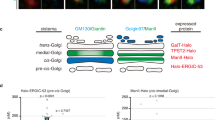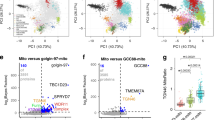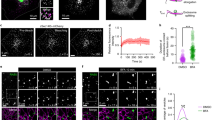Abstract
As with other complex cellular functions, intracellular membrane transport involves the coordinated engagement of a series of organelles and machineries; however, the molecular basis of this coordination is unknown. Here we describe a Golgi-based signalling system that is activated by traffic and is involved in monitoring and balancing trafficking rates into and out of the Golgi complex. We provide evidence that the traffic signal is due to protein chaperones that leave the endoplasmic reticulum and reach the Golgi complex where they bind to the KDEL receptor. This initiates a signalling reaction that includes the activation of a Golgi pool of Src kinases and a phosphorylation cascade that in turn activates intra-Golgi trafficking, thereby maintaining the dynamic equilibrium of the Golgi complex. The concepts emerging from this study should help to understand the control circuits that coordinate high-order cellular functions.
This is a preview of subscription content, access via your institution
Access options
Subscribe to this journal
Receive 12 print issues and online access
$209.00 per year
only $17.42 per issue
Buy this article
- Purchase on Springer Link
- Instant access to full article PDF
Prices may be subject to local taxes which are calculated during checkout








Similar content being viewed by others
References
Heinrich, R. & Rapoport, T. A. Generation of nonidentical compartments in vesicular transport systems. J. Cell Biol. 168, 271–280 (2005).
Donaldson, J. G. & Lippincott-Schwartz, J. Sorting and signaling at the Golgi complex. Cell 101, 693–696 (2000).
Sallese, M., Pulvirenti, T., & Luini, A. The physiology of membrane transport and endomembrane-based signalling. EMBO J. 25, 2663–2673 (2006).
De Matteis, M. A., Santini, G., Kahn, R. A., Di Tullio, G., & Luini, A. Receptor and protein kinase C-mediated regulation of ARF binding to the Golgi complex. Nature 364, 818–821 (1993).
Luton, F., Verges, M., Vaerman, J. P., Sudol, M., & Mostov, K. E. The SRC family protein tyrosine kinase p62yes controls polymeric IgA transcytosis in vivo. Mol. Cell 4, 627–632 (1999).
Sorkin, A. & Von Zastrow, M. Signal transduction and endocytosis: close encounters of many kinds. Nature Rev. Mol. Cell Biol. 3, 600–614 (2002).
Di Fiore, P. P. & De Camilli, P. Endocytosis and signaling. an inseparable partnership. Cell 106, 1–4 (2001).
Bivona, T. G. et al. Phospholipase Cγ activates Ras on the Golgi apparatus by means of RasGRP1. Nature 424, 694–698 (2003).
Sorkin, A. TRKing signals through the Golgi. Sci. STKE. 2005, e1 (2005).
Rocks, O. et al. An acylation cycle regulates localization and activity of palmitoylated Ras isoforms. Science 307, 1746–1752 (2005).
Michaelson, D., Ahearn, I., Bergo, M., Young, S., & Philips, M. Membrane trafficking of heterotrimeric G proteins via the endoplasmic reticulum and Golgi. Mol. Biol. Cell 13, 3294–3302 (2002).
Trucco, A. et al. Secretory traffic triggers the formation of tubular continuities across Golgi sub-compartments. Nature Cell Biol. 6, 1071–1081 (2004).
Mironov, A. A. et al. Small cargo proteins and large aggregates can traverse the Golgi by a common mechanism without leaving the lumen of cisternae. J. Cell Biol. 155, 1225–1238 (2001).
Bonfanti, L. et al. Procollagen traverses the Golgi stack without leaving the lumen of cisternae: evidence for cisternal maturation. Cell 95, 993–1003 (1998).
Bjorge, J. D., Jakymiw, A., & Fujita, D. J. Selected glimpses into the activation and function of Src kinase. Oncogene 19, 5620–5635 (2000).
Thomas, S. M. & Brugge, J. S. Cellular functions regulated by Src family kinases. Annu. Rev. Cell Dev. Biol. 13, 513–609 (1997).
Bard, F. et al. Molecular complexes that contain both c-Cbl and c-Src associate with Golgi membranes. Eur. J. Cell Biol. 81, 26–35 (2002).
Bijlmakers, M. J., Isobe-Nakamura, M., Ruddock, L. J., & Marsh, M. Intrinsic signals in the unique domain target p56(lck) to the plasma membrane independently of CD4. J. Cell Biol. 137, 1029–1040 (1997).
Carreno, S., Gouze, M. E., Schaak, S., Emorine, L. J., & Maridonneau-Parini, I. Lack of palmitoylation redirects p59Hck from the plasma membrane to p61Hck-positive lysosomes. J. Biol. Chem. 275, 36223–36229 (2000).
Li, M. et al. The SH3 domain of Lck modulates T-cell receptor-dependent activation of extracellular signal-regulated kinase through activation of Raf-1. Mol. Cell Biol. 28, 630–641 (2008).
Hiyoshi, M. et al. Interaction between Hck and HIV-1 Nef negatively regulates cell surface expression of M-CSF receptor. Blood 111, 243–250 (2008).
Meyn, M. A., III, Schreiner, S. J., Dumitrescu, T. P., Nau, G. J., & Smithgall, T. E. SRC family kinase activity is required for murine embryonic stem cell growth and differentiation. Mol. Pharmacol. 68, 1320–1330 (2005).
Blake, R. A. et al. SU6656, a selective src family kinase inhibitor, used to probe growth factor signaling. Mol. Cell Biol. 20, 9018–9027 (2000).
Bard, F., Mazelin, L., Pechoux-Longin, C., Malhotra, V., & Jurdic, P. Src regulates Golgi structure and KDEL receptor-dependent retrograde transport to the endoplasmic Reticulum. J. Biol. Chem. 278, 46601–46606 (2003).
Canty, E. G. & Kadler, K. E. Procollagen trafficking, processing and fibrillogenesis. J. Cell Sci. 118, 1341–1353 (2005).
Green, H. & Goldberg, B. Synthesis of collagen by mammalian cell lines of fibroblastic and nonfibroblastic origin. Proc. Natl Acad. Sci. USA 53, 1360–1365 (1965).
Scheel, A. A. & Pelham, H. R. Identification of amino acids in the binding pocket of the human KDEL receptor. J. Biol. Chem. 273, 2467–2472 (1998).
Munro, S. & Pelham, H. R. A C-terminal signal prevents secretion of luminal ER proteins. Cell 48, 899–907 (1987).
Pelham, H. R. Recycling of proteins between the endoplasmic reticulum and Golgi complex. Curr. Opin. Cell Biol. 3, 585–591 (1991).
Aoe, T. et al. The KDEL receptor, ERD2, regulates intracellular traffic by recruiting a GTPase-activating protein for ARF1. EMBO J 16, 7305–16 (1997).
Majoul, I. et al. KDEL receptor (Erd2p)-mediated retrograde transport of the cholera toxin A subunit from the Golgi involves COPI, p23, and the COOH terminus of Erd2p. J. Cell Biol. 143, 601–12 (1998).
Semenza, J. C., Hardwick, K. G., Dean, N., & Pelham, H. R. ERD2, a yeast gene required for the receptor-mediated retrieval of luminal ER proteins from the secretory pathway. Cell 61, 1349–1357 (1990).
Lewis, M. J. & Pelham, H. R. A human homologue of the yeast HDEL receptor. Nature 348, 162–163 (1990).
Cabrera, M. et al. The retrieval function of the KDEL receptor requires PKA phosphorylation of its C terminus. Mol. Biol. Cell 14, 4114–4125 (2003).
Yamamoto, K. et al. The KDEL receptor modulates the endoplasmic reticulum stress response through mitogen-activated protein kinase signaling cascades. J. Biol. Chem. 278, 34525–34532 (2003).
Johannes, L., Tenza, D., Antony, C., & Goud, B. Retrograde transport of KDEL-bearing B-fragment of Shiga toxin. J. Biol. Chem. 272, 19554–19561 (1997).
Keusch, G. T. et al. Globotriaosylceramide, Gb3, is an alternative functional receptor for Shiga-like toxin 2e. Infect. Immun. 63, 1138–1141 (1995).
Valderrama, F. et al. Actin microfilaments facilitate the retrograde transport from the Golgi complex to the endoplasmic reticulum in mammalian cells. Traffic 2, 717–726 (2001).
Connolly, C. N., Futter, C. E., Gibson, A., Hopkins, C. R., & Cutler, D. F. Transport into and out of the Golgi complex studied by transfecting cells with cDNAs encoding horseradish peroxidase. J. Cell Biol. 127, 641–652 (1994).
Hsu, V. W., Shah, N., & Klausner, R. D. A brefeldin A-like phenotype is induced by the overexpression of a human ERD-2-like protein, ELP-1. Cell 69, 625–635 (1992).
Townsley, F. M., Wilson, D. W., & Pelham, H. R. Mutational analysis of the human KDEL receptor: distinct structural requirements for Golgi retention, ligand binding and retrograde transport. EMBO J. 12, 2821–2829 (1993).
McGarrigle, D. & Huang, X. Y. GPCRs signaling directly through Src-family kinases. Sci. STKE. 2007, e35 (2007).
Bain, J., McLauchlan, H., Elliott, M., & Cohen, P. The specificities of protein kinase inhibitors: an update. Biochem. J. 371, 199–204 (2003).
Klinghoffer, R. A., Sachsenmaier, C., Cooper, J. A., & Soriano, P. Src family kinases are required for integrin but not PDGFR signal transduction. EMBO J. 18, 2459–2471 (1999).
Arcaro, A. et al. Critical role for lipid raft-associated Src kinases in activation of PI3K–Akt signalling. Cell Signal. 19, 1081–1092 (2007).
Austin, C. D. & Shields, D. Formation of nascent secretory vesicles from the trans-Golgi network of endocrine cells is inhibited by tyrosine kinase and phosphatase inhibitors. J. Cell Biol. 135, 1471–1483 (1996).
Webb, R. J., Judah, J. D., Lo, L. C., & Thomas, G. M. 3Constitutive secretion of serum albumin requires reversible protein tyrosine phosphorylation events in trans-Golgi. Am. J. Physiol Cell Physiol 289, C748–C756 (2005).
Pelkmans, L. et al. Genome-wide analysis of human kinases in clathrin- and caveolae/raft-mediated endocytosis. Nature 436, 78–86 (2005).
Griffiths, G. et al. Localization of the Lys, Asp, Glu, Leu tetrapeptide receptor to the Golgi complex and the intermediate compartment in mammalian cells. J. Cell Biol. 127, 1557–1574 (1994).
Majoul, I., Straub, M., Hell, S. W., Duden, R., & Soling, H. D. KDEL-cargo regulates interactions between proteins involved in COPI vesicle traffic: measurements in living cells using FRET. Dev. Cell 1, 139–53 (2001).
Cetkovic, H., Grebenjuk, V. A., Muller, W. E., & Gamulin, V. Src proteins/src genes: from sponges to mammals. Gene 342, 251–261 (2004).
Patil, C. & Walter, P. Intracellular signaling from the endoplasmic reticulum to the nucleus: the unfolded protein response in yeast and mammals. Curr. Opin. Cell Biol. 13, 349–355 (2001).
Xia, Z. P. & Chen, Z. J. TRAF2: a double-edged sword? Sci. STKE. 2005, e7 (2005).
Altan-Bonnet, N., Phair, R. D., Polishchuk, R. S., Weigert, R., & Lippincott-Schwartz, J. A role for Arf1 in mitotic Golgi disassembly, chromosome segregation, and cytokinesis. Proc. Natl Acad. Sci. USA 100, 13314–13319 (2003).
Preisinger, C. et al. YSK1 is activated by the Golgi matrix protein GM130 and plays a role in cell migration through its substrate 14–3-3ζ. J. Cell Biol. 164, 1009–1020 (2004).
Matsuda, D. et al. Involvement of Golgi-associated Lyn tyrosine kinase in the translocation of annexin II to the endoplasmic reticulum under oxidative stress. Exp. Cell Res. 312, 1205–1217 (2006).
Bonazzi, M. et al. CtBP3/BARS drives membrane fission in dynamin-independent transport pathways. Nature Cell Biol. 7, 570–580 (2005).
Mironov, A. A. et al. ER-to-Golgi carriers arise through direct en bloc protrusion and multistage maturation of specialized ER exit domains. Dev. Cell 5, 583–594 (2003).
Polishchuk, R., Di Pentima, A., & Lippincott-Schwartz, J. Delivery of raft-associated, GPI-anchored proteins to the apical surface of polarized MDCK cells by a transcytotic pathway. Nat. Cell Biol. 6, 297–307 (2004).
Mironov, A. et al. Role of NAD+ and ADP-ribosylation in the maintenance of the Golgi structure. J. Cell Biol. 139, 1109–1118 (1997).
Acknowledgements
We thank M. A. De Matteis and A. Colanzi for critical reading of the manuscript, C. P. Berrie for editorial assistance and E. Fontana for artwork preparation. We thank C. Ruggiero for experimental help and P. Randazzo, M. Frame, P. Cohen, K. Kadler and T. Smithgall for helpful discussions, and several other colleagues for sharing reagents (see Methods). We thank Telethon (Italy), AIRC (Italy) and MIUR (Italy) for financial support. T.P., M.G., Ma.C. and Mi.C. are or were FIRC Fellows. T.P. was a recipient of a Fellowship from Fondazioni Bancarie Abruzzesi and Fondazione Negri Sud ONLUS.
Author information
Authors and Affiliations
Contributions
T.P., M.S. and A.L. conceived and designed the study; T.P., M.G., Ma.C., Mi.C., A.P., R.P., E.S.P., G.V.B., A.A.M., G.T. and V.W.H. performed the experiments; M.S. and A.L. prepared the manuscript.
Corresponding authors
Ethics declarations
Competing interests
The authors declare no competing financial interests.
Supplementary information
Supplementary Information
Supplementary Figures S1, S2, S3, S4, S5, S6, S7, S8 and Supplementary Information (PDF 1820 kb)
Rights and permissions
About this article
Cite this article
Pulvirenti, T., Giannotta, M., Capestrano, M. et al. A traffic-activated Golgi-based signalling circuit coordinates the secretory pathway. Nat Cell Biol 10, 912–922 (2008). https://doi.org/10.1038/ncb1751
Received:
Accepted:
Published:
Issue Date:
DOI: https://doi.org/10.1038/ncb1751
This article is cited by
-
KDELR2-KIF20A axis facilitates bladder cancer growth and metastasis by enhancing Golgi-mediated secretion
Biological Procedures Online (2022)
-
ACBD3 modulates KDEL receptor interaction with PKA for its trafficking via tubulovesicular carrier
BMC Biology (2021)
-
KDEL receptor is a cell surface receptor that cycles between the plasma membrane and the Golgi via clathrin-mediated transport carriers
Cellular and Molecular Life Sciences (2021)
-
Transcriptomics of a KDELR1 knockout cell line reveals modulated cell adhesion properties
Scientific Reports (2019)
-
KDEL receptor regulates secretion by lysosome relocation- and autophagy-dependent modulation of lipid-droplet turnover
Nature Communications (2019)



